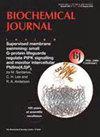Engineering of CYP82Y1, a cytochrome P450 monooxygenase: a key enzyme in noscapine biosynthesis in opium poppy
IF 4.4
3区 生物学
Q2 BIOCHEMISTRY & MOLECULAR BIOLOGY
引用次数: 0
Abstract
Protein engineering provides a powerful base for the circumvention of challenges tied with characteristics accountable for enzyme functions. CYP82Y1 introduces a hydroxyl group (−OH) into C1 of N-methylcanadine as the substrate to yield 1-hydroxy-N-methylcanadine. This chemical process has been found to be the gateway to noscapine biosynthesis. Owning to the importance of CYP82Y1 in this biosynthetic pathway, it has been selected as a target for enzyme engineering. The insertion of tags to the N- and C-terminal of CYP82Y1 was assessed for their efficiencies for improvement of the physiological performances of CYP82Y1. Although these attempts achieved some positive results, further strategies are required to dramatically enhance the CYP82Y1 activity. Here methods that have been adopted to achieve a functionally improved CYP82Y1 will be reviewed. In addition, the possibility of recruitment of other techniques having not yet been implemented in CYP82Y1 engineering, including the substitution of the residues located in the substrate recognition site, formation of the synthetic fusion proteins, and construction of the artificial lipid-based scaffold will be discussed. Given the fact that the pace of noscapine synthesis is constrained by the CYP82Y1-catalyzing step, the methods proposed here are capable of accelerating the rate of reaction performed by CYP82Y1 through improving its properties, resulting in the enhancement of noscapine accumulation.细胞色素 P450 单加氧酶 CYP82Y1 的工程化:罂粟中诺卡品生物合成的关键酶
蛋白质工程为克服与酶功能特性相关的挑战提供了强大的基础。CYP82Y1 将羟基(-OH)引入作为底物的 N-甲基卡那定的 C1,生成 1-羟基-N-甲基卡那定。这一化学过程被认为是诺卡品生物合成的入口。由于 CYP82Y1 在这一生物合成途径中的重要性,因此被选为酶工程的目标。我们评估了在 CYP82Y1 的 N 端和 C 端插入标签以改善 CYP82Y1 生理性能的效果。尽管这些尝试取得了一些积极的成果,但还需要进一步的策略来显著提高 CYP82Y1 的活性。在此,我们将回顾为实现 CYP82Y1 的功能改进而采用的方法。此外,还将讨论在 CYP82Y1 工程中采用其他尚未实施的技术的可能性,包括底物识别位点残基的替代、合成融合蛋白的形成以及人工脂基支架的构建。鉴于诺卡品的合成速度受到 CYP82Y1 催化步骤的限制,本文提出的方法能够通过改善 CYP82Y1 的特性来加快其反应速度,从而提高诺卡品的积累。
本文章由计算机程序翻译,如有差异,请以英文原文为准。
求助全文
约1分钟内获得全文
求助全文
来源期刊

Biochemical Journal
生物-生化与分子生物学
CiteScore
8.00
自引率
0.00%
发文量
255
审稿时长
1 months
期刊介绍:
Exploring the molecular mechanisms that underpin key biological processes, the Biochemical Journal is a leading bioscience journal publishing high-impact scientific research papers and reviews on the latest advances and new mechanistic concepts in the fields of biochemistry, cellular biosciences and molecular biology.
The Journal and its Editorial Board are committed to publishing work that provides a significant advance to current understanding or mechanistic insights; studies that go beyond observational work using in vitro and/or in vivo approaches are welcomed.
Painless publishing:
All papers undergo a rigorous peer review process; however, the Editorial Board is committed to ensuring that, if revisions are recommended, extra experiments not necessary to the paper will not be asked for.
Areas covered in the journal include:
Cell biology
Chemical biology
Energy processes
Gene expression and regulation
Mechanisms of disease
Metabolism
Molecular structure and function
Plant biology
Signalling
 求助内容:
求助内容: 应助结果提醒方式:
应助结果提醒方式:


